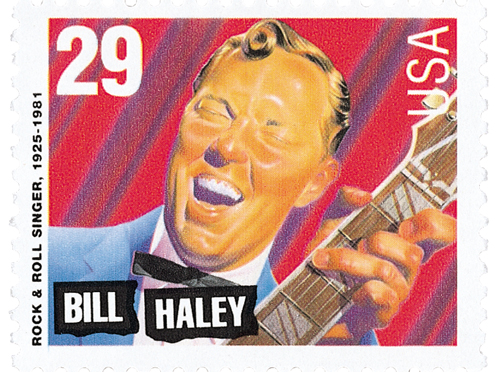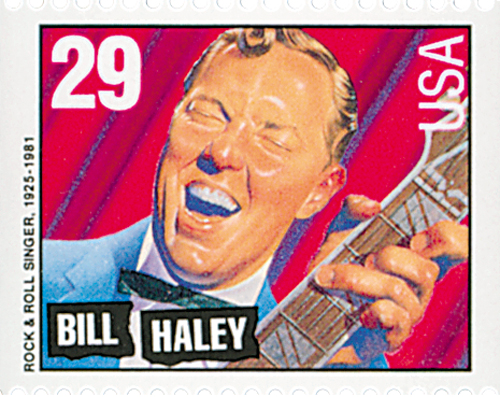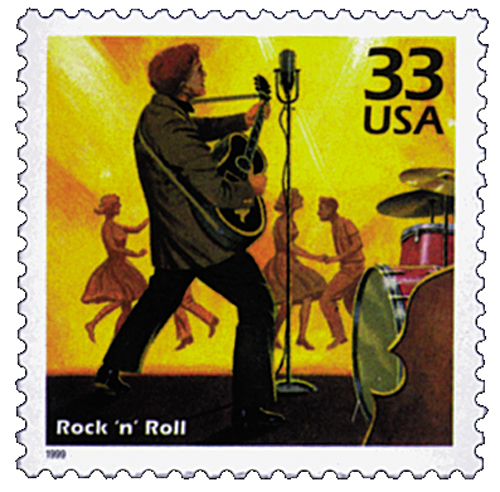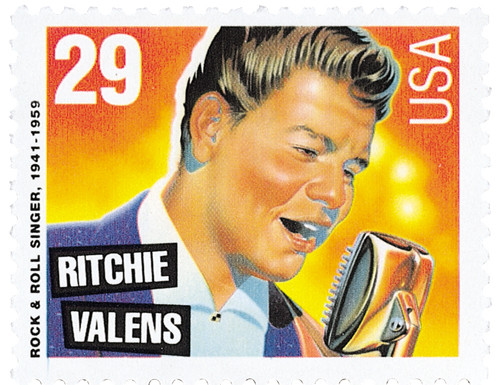
# 2725 - 1993 29c Legends of American Music: Bill Haley
29¢ Bill Haley
Legends of American Music
City: Cleveland, OH or Santa Monica, CA
Quantity: 14,285,715
Printed By: Stamp Venturers
Printing Method: Photogravure
Perforations: 10
Color: Multicolored
Birth of Bill Haley

William John Clifton Haley was born on July 6, 1925, in Highland Park, Michigan. Called the “father of the rock revolution,” Haley and his band, the Comets, are credited with recording some of the first rock ‘n’ roll hits.
In 1929, Haley underwent an operation on his inner ear. A mistake was made that severed an optic nerve and left him blind in his left eye. Haley’s parents were both musicians – his father played the banjo and mandolin, and his mother played the keyboard. Haley claimed that as a child he made his own guitar out of cardboard, leading his parents to buy him a real one.

During the Depression, the Haley family moved to Bethel, Pennsylvania. Haley had one of his first stage appearances there when he was 13, playing guitar at an event for the Bethel Junior baseball team. Haley left home when he was 15 in search of fame and fortune. He sang and yodeled with several different bands – he was considered one of the country’s best yodelers and was called “Silver Yodeling Bill Haley.” He performed with the Down Homers and the Four Aces of Western Swing before starting his own country band, The Saddlemen, with which he was called “The Rambling Yodeler.”
The Saddlemen played dances, school events, and clubs around Philadelphia. Although they had their beginnings in the country music field, Haley and his band soon began adding Dixie, rhythm & blues, and pop – helping to create a whole new sound known as rock ‘n’ roll. The band changed its name during Labor Day weekend, 1952, to Bill Haley with Haley’s Comets, inspired by Halley’s Comet.

In 1953, Haley wrote and his band recorded “Crazy Man, Crazy,” which is considered the first rock and roll song to make it onto the American music charts, reaching #15 on Billboard. Shortly after, the band became Bill Haley & His Comets.

The band recorded Joe Turner’s hit “Shake, Rattle, and Roll” in 1954. It became a number-one best seller and placed Bill Haley and His Comets in the spotlight. A year later, his original composition “Rock Around the Clock” became one of the biggest selling singles in the world, reaching number one on the pop charts for seven weeks in a row. Featured as the theme song in the movie Blackboard Jungle, Haley’s song gave teenagers a music all their own. Haley’s appearances on Milton Berle’s Texaco Star Theater and the Ed Sullivan Show in 1955 marked some of the first nationally televised rock ‘n’ roll performances, helping to bring the new musical genre into people’s homes.

“Rock Around the Clock” is widely considered to mark the start of the age of rock music. It was also the first record to sell more than one million copies in Britain and Germany. Haley went on to become the first major American rock singer to tour Europe. And in 1956, he starred in the first rock and roll musical films, Rock Around the Clock and Don’t Knock the Rock.

Blazing new trails in both the US and Europe, Haley’s success laid the groundwork for Elvis and other rising rock stars of the 1950s. Though their successes soon surpassed his, Haley continued to have hits, such as “See You Later, Alligator.” Haley remained popular through much of the sixties and performed for Queen Elizabeth II at the Royal Variety Performance in 1979.
Haley had struggled with alcohol throughout his life and his behavior became increasingly erratic in his final years before his death on February 9, 1981. He was posthumously inducted into the Rock and Roll Hall of Fame in 1987 and the National Rhythm and Blues Hall of Fame in 2017. In 2006, an asteroid was named Billhaley to mark the 25th anniversary of the star’s death.
29¢ Bill Haley
Legends of American Music
City: Cleveland, OH or Santa Monica, CA
Quantity: 14,285,715
Printed By: Stamp Venturers
Printing Method: Photogravure
Perforations: 10
Color: Multicolored
Birth of Bill Haley

William John Clifton Haley was born on July 6, 1925, in Highland Park, Michigan. Called the “father of the rock revolution,” Haley and his band, the Comets, are credited with recording some of the first rock ‘n’ roll hits.
In 1929, Haley underwent an operation on his inner ear. A mistake was made that severed an optic nerve and left him blind in his left eye. Haley’s parents were both musicians – his father played the banjo and mandolin, and his mother played the keyboard. Haley claimed that as a child he made his own guitar out of cardboard, leading his parents to buy him a real one.

During the Depression, the Haley family moved to Bethel, Pennsylvania. Haley had one of his first stage appearances there when he was 13, playing guitar at an event for the Bethel Junior baseball team. Haley left home when he was 15 in search of fame and fortune. He sang and yodeled with several different bands – he was considered one of the country’s best yodelers and was called “Silver Yodeling Bill Haley.” He performed with the Down Homers and the Four Aces of Western Swing before starting his own country band, The Saddlemen, with which he was called “The Rambling Yodeler.”
The Saddlemen played dances, school events, and clubs around Philadelphia. Although they had their beginnings in the country music field, Haley and his band soon began adding Dixie, rhythm & blues, and pop – helping to create a whole new sound known as rock ‘n’ roll. The band changed its name during Labor Day weekend, 1952, to Bill Haley with Haley’s Comets, inspired by Halley’s Comet.

In 1953, Haley wrote and his band recorded “Crazy Man, Crazy,” which is considered the first rock and roll song to make it onto the American music charts, reaching #15 on Billboard. Shortly after, the band became Bill Haley & His Comets.

The band recorded Joe Turner’s hit “Shake, Rattle, and Roll” in 1954. It became a number-one best seller and placed Bill Haley and His Comets in the spotlight. A year later, his original composition “Rock Around the Clock” became one of the biggest selling singles in the world, reaching number one on the pop charts for seven weeks in a row. Featured as the theme song in the movie Blackboard Jungle, Haley’s song gave teenagers a music all their own. Haley’s appearances on Milton Berle’s Texaco Star Theater and the Ed Sullivan Show in 1955 marked some of the first nationally televised rock ‘n’ roll performances, helping to bring the new musical genre into people’s homes.

“Rock Around the Clock” is widely considered to mark the start of the age of rock music. It was also the first record to sell more than one million copies in Britain and Germany. Haley went on to become the first major American rock singer to tour Europe. And in 1956, he starred in the first rock and roll musical films, Rock Around the Clock and Don’t Knock the Rock.

Blazing new trails in both the US and Europe, Haley’s success laid the groundwork for Elvis and other rising rock stars of the 1950s. Though their successes soon surpassed his, Haley continued to have hits, such as “See You Later, Alligator.” Haley remained popular through much of the sixties and performed for Queen Elizabeth II at the Royal Variety Performance in 1979.
Haley had struggled with alcohol throughout his life and his behavior became increasingly erratic in his final years before his death on February 9, 1981. He was posthumously inducted into the Rock and Roll Hall of Fame in 1987 and the National Rhythm and Blues Hall of Fame in 2017. In 2006, an asteroid was named Billhaley to mark the 25th anniversary of the star’s death.
















